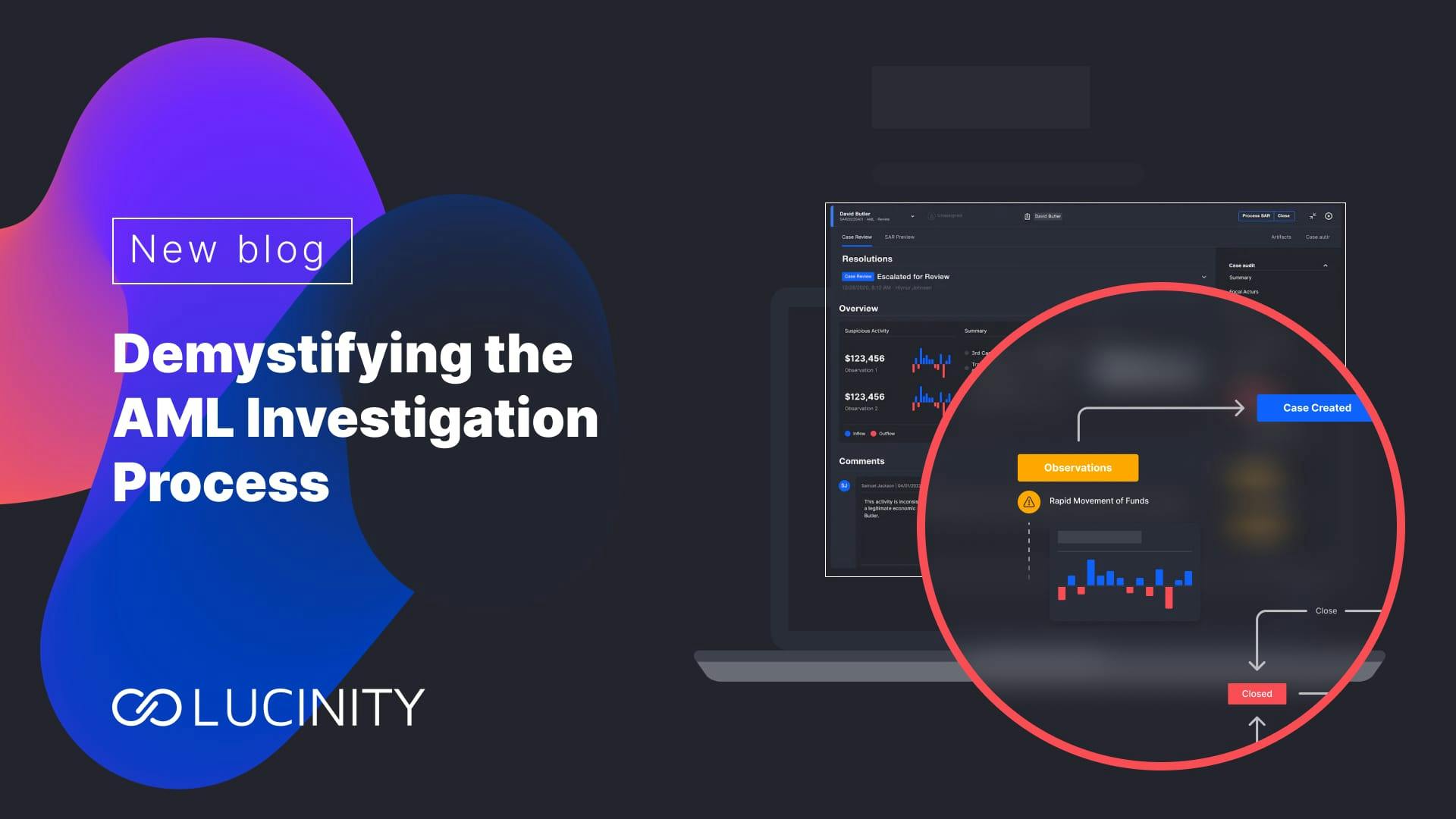The Future of AML Surveillance: The Role of AI in Anti-Money Laundering Compliance and Risk Mitigation
Explore how AI transforms AML Surveillance, enhancing compliance and mitigating risks in the evolving financial sector. Discover AI's role in AML now.
The application of artificial intelligence (AI) in AML surveillance has emerged as an important development in response to new financial challenges and economic changes. Advanced AML surveillance techniques and strategies supported by AI have become increasingly instrumental in the digitalized financial market. In fact, AI promises to reform the way compliance and risk mitigation are approached in the financial sector. So, let’s understand what makes AI effective for AML and what impact it will have.
Understanding AML Surveillance
AML surveillance involves the vigilant monitoring of financial transactions to detect, deter, and report money laundering activities. It forms the backbone of financial institutions' strategies to combat financial crime, aligning with legal mandates and contributing to the global fight against illicit financial flows. This process is multifaceted, involving various AML Surveillance techniques to ensure a thorough examination of financial operations and prevent the misuse of the financial system for money laundering purposes.
Key AML surveillance techniques include data-driven analysis, entity and transaction resolution, segmentation, automation for efficiency, collaborative investigations, and advanced monitoring for sanctions evasion. These methods collectively enhance the ability of financial institutions to identify suspicious activities. For instance, data-driven analysis helps in understanding customer behavior patterns, while automated systems streamline the investigative process, reducing the reliance on manual research and allowing for real-time response to potential risks.
Through these sophisticated techniques, AML surveillance plays an important role in maintaining the financial sector’s integrity, safeguarding it from being exploited for money laundering. It also ensures that institutions comply with regulatory requirements, and this contributes to a more transparent and secure global financial environment.
The Role of Artificial Intelligence and Advanced Technology in Enhancing AML Surveillance
AI is powering effective strategies for identifying, preventing, and reporting money laundering activities, ensuring compliance with intricate international legal standards, and safeguarding the financial system's integrity by minimizing dynamic risks. Let’s study the transformative role of AI and related technology in enhancing AML surveillance-
AI-Driven Risk Assessment
The advent of artificial intelligence (AI) has transformed AML surveillance by enabling a nuanced and comprehensive risk assessment process. AI-driven AML surveillance tools, through their advanced algorithms, provide a deeper understanding of potential risks, significantly improving the detection and analysis of illicit financial activities. These AML surveillance tools can process vast amounts of data rapidly, identifying patterns and anomalies that may indicate money laundering or other financial crimes. Here are some AML red flags that AI-enhanced systems can easily detect, unlike older systems:
- Unusual transaction patterns that are often complex and subtle; often detected by integrating various data sources
- Unusual transaction structures in high-risk geographies and complex structures
- Rapid fund movement and discrepancies between a customer’s profile and their transaction behaviors
- Emerging money laundering tactics that require quick and intelligent adaptation to detect
Streamlining Processes and Enhancing Efficiency
AI not only enhances risk assessment but also streamlines the entire AML surveillance process. By automating routine tasks, AI reduces the manual workload on compliance teams, allowing them to focus on more strategic activities. Machine learning, a subset of AI, plays an important role here by continuously learning from data inputs, thereby refining the surveillance process and increasing operational efficiency over time.
Predictive Analytics and Proactive Risk Management
AI’s capability extends to predictive analytics, where it analyzes historical and real-time data to forecast potential risks and illicit activities. This proactive approach enables financial institutions to stay ahead of financial criminals, implementing preventative measures before any significant issues arise. AI systems can also integrate various data sources, offering a holistic view of customer activities and enhancing the overall surveillance mechanism.
Real-Time Monitoring for Immediate Action
One of the standout features of AI in AML surveillance is its ability to facilitate real-time monitoring and analysis. This ensures that any suspicious transaction or activity is flagged and investigated promptly, allowing for immediate action to prevent potential money laundering.
The integration of AI into AML is a significant leap forward in the efficiency and effectiveness of financial crime prevention. As AI technology continues to evolve, it promises to bring even more sophisticated tools and methodologies to enhance the AML surveillance capabilities of financial institutions.
AI-powered Advanced-Data Analytics Platforms
In the realm of AML surveillance, data analytics platforms stand out by offering sophisticated capabilities to detect patterns and anomalies indicative of money laundering. These platforms typically harness AI, ML, and big data. They employ advanced algorithms and machine learning to sift through vast datasets and uncover suspicious activities. By integrating various data sources, these tools provide a comprehensive analysis, enabling financial institutions to make informed decisions and take proactive measures against financial crimes.
Case Management Solutions
Case management tools are vital for organizing, investigating, and documenting suspicious activities detected during AML surveillance. They provide a structured framework for managing cases, from initial alerts to investigations, reporting, and resolution. These tools ensure that all relevant information is captured, aiding in the thorough analysis and swift action on potential money laundering cases.
Compliance and Regulatory Reporting Software
Compliance software helps financial institutions tackle the complexities of regulatory reporting and compliance requirements. These tools streamline the process of generating reports, managing records, and ensuring that all AML activities are in line with regulatory standards, thereby enforcing due diligence and reducing the risk of non-compliance and associated penalties.
Blockchain Analysis Tools
With the rise of cryptocurrency and digital assets, blockchain analysis tools have become increasingly important in AML surveillance. These tools specialize in tracking and analyzing blockchain transactions, identifying patterns of illicit activity, and providing insights into the flow of digital currencies. They enable institutions to monitor cryptocurrency transactions effectively, ensuring that these innovative financial channels are not exploited for money laundering.
AI Co-Pilots
AI copilot tools can automate data analysis for AML (Anti-Money Laundering), quickly identify suspicious activities, and provide insightful recommendations, thereby streamlining the compliance process and reducing manual workload.
The integration of AI and other advanced technology marks an urgent advancement in AML surveillance, enhancing the ability of financial institutions to tackle financial crime while moderating the required costs or time investment. AI’s predictive capabilities, combined with the comprehensive analysis provided by other technological tools, create a powerful mechanism for proactive risk mitigation and compliance.
Powering the Future: Lucinity’s AML Surveillance Solutions
Looking ahead, AML surveillance is poised for significant improvement, enabling greater accuracy and adaptation to increasingly complex financial crimes. The integration of AI, machine learning, big data, and collaborative networks will particularly drive progress in detecting and preventing financial crime.
So, financial institutions need to build greater agility, adopting new technologies and strategies to stay ahead of criminals and comply with evolving regulatory requirements. Lucinity is spearheading this transformation with its anti money laundering surveillance and compliance solutions, which we will now discuss.
Tailored AML Strategies with Lucinity’s SaaS Platform
Lucinity’s Software-as-a-Service (SaaS) platform stands out in the AML domain for its potent combination of advanced AI capabilities and user-centered design. Our platform is engineered to augment the human element in AML processes, blending sophisticated machine-learning algorithms with intuitive interfaces to enhance decision-making and operational efficiency.
Case Manager: A Unified Investigative Platform
At the heart of our AML solutions is the Lucinity Case Manager. This tool unifies various data points and signals into a cohesive platform, providing financial institutions with a comprehensive view of their AML landscape. By integrating alerts from third-party sources and internal AML transaction monitoring systems, it facilitates a holistic approach to financial crime investigation, ensuring no detail is overlooked.
Customer Intelligence with AI-Driven Insights
Lucinity's Customer Intelligence module, also known as 'Profiles', delivers a 360-degree view of customer activities by harmonizing data from KYC, transactions, and external datasets. Powered by AI, it automatically updates risk scores and conducts behavior analysis, enabling compliance teams to detect and act on suspicious patterns swiftly.
Regulatory Reporting Made Efficient
Our Regulatory Reporting solution streamlines the suspicious activity report filing process, reducing it from hours to minutes. It automates data validation, creates a seamless narrative for reports, and directly files them with authorities. This efficiency saves time and also ensures accuracy and compliance with regulatory standards.
Luci Copilot: AI at Your Side
The Luci Copilot, Lucinity’s flagship AI technology, epitomizes our innovative approach. Luci uses GPT-powered generative AI to analyze financial data, offering clear, actionable insights. It assists teams in learning and adapting to AML challenges, enhancing their investigative capabilities, and ensuring consistent, high-quality case outcomes.
Augmented Intelligence: Merging AI with Human Expertise
Lucinity’s philosophy of 'Human AI' is about enhancing human potential. Our platform is designed to augment rather than replace human intelligence, providing teams with tools that streamline workflows, reduce manual tasks, and allow them to focus on high-value strategic work.
Global Reach with Local Insight
While headquartered in Reykjavik, Iceland, Lucinity serves a global market, understanding the nuanced needs of diverse financial ecosystems. Our platform is configurable to align with local regulatory environments and operational requirements, offering a globally informed, yet locally applicable, AML solution.
Future-Proofing Compliance with Continuous Innovation
Lucinity is also committed to continuous innovation, ensuring our solutions remain at the cutting edge of AML surveillance technology. We empower our clients to stay ahead of financial crime trends and changes in AML regulations, safeguarding their operations against future threats.
Key Takeaways: Anti-Money Laundering in the AI Era
As the financial sector adapts to the complications of modern money laundering tactics, AI-driven tools have become indispensable by effectively enhancing AML surveillance and ensuring robust AML compliance. Let’s reiterate some important points from our discussion on this development-
- Technological Evolution- The integration of AI and machine learning into AML surveillance systems has significantly improved the ability to detect and prevent money laundering, showcasing the importance of technological evolution in maintaining financial integrity.
- Comprehensive Surveillance- Effective AML surveillance extends beyond transaction monitoring to include a nuanced analysis of customer behavior, real-time risk assessment, and predictive analytics, all of which are augmented by AI capabilities.
- Innovative Tools and Integration- The adoption of advanced data analytics platforms, CRM systems, case management tools, and blockchain analysis technologies underscores the trend towards comprehensive, integrated surveillance ecosystems.
- Collaboration and Global Reach- The fight against money laundering requires global cooperation and data sharing among financial institutions, regulatory bodies, and law enforcement agencies, facilitated by scalable and adaptable platforms like Lucinity's.
- Future-Ready Compliance- Staying ahead in AML surveillance necessitates a proactive approach, embracing continuous innovation and adopting solutions that can adapt to both current and future regulatory and criminal landscapes.
- Lucinity's Transformational Role- Lucinity emerges as a decisive player in this evolving domain, offering tailored, AI-enhanced AML solutions that empower financial institutions to overcome the complexities of compliance and risk mitigation effectively.
As we look towards a future where financial transactions continue to grow in volume and complexity, the role of AI in AML surveillance will become increasingly central. AI-driven tools and platforms like Lucinity will play a growing role in anticipating and counteracting sophisticated money laundering schemes to ensure a more risk-free and compliant financial environment.


